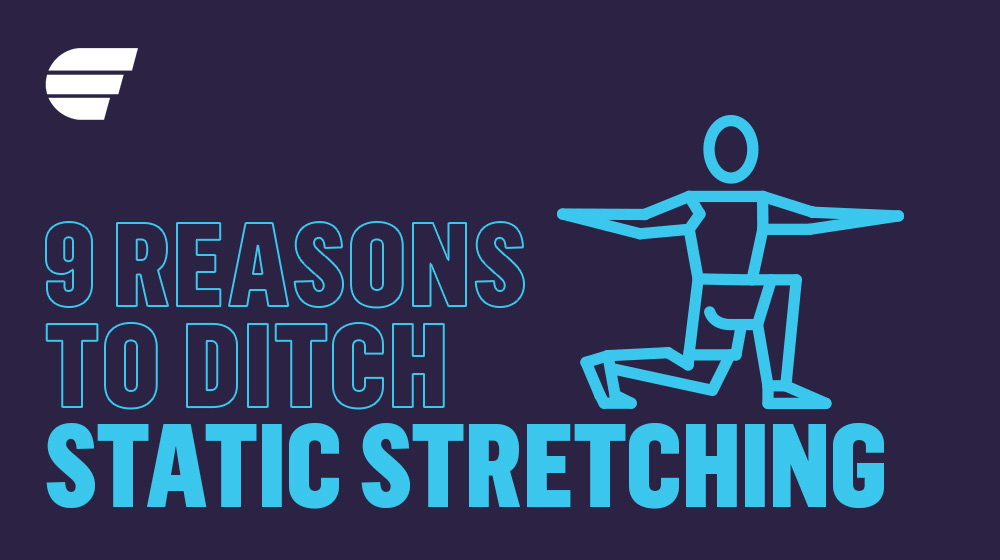Does static stretching help the body perform better? Every serious gym-goer needs to know what type of stretches will help them achieve peak athletic performance. Here’s what you need to know about static stretching and why it’s bad for you.
9 Reasons to Ditch Static Stretching When Warming Up
Static Stretching Definition: It is a stretch held at a comfortable position for around 10 to 30 seconds to improve overall flexibility. Learn more about static stretching here.
Dynamic Stretching Definition: It is a stretch accompanied by a range of motion repeated 10 to 12 times. Dynamic stretching is believed to improve the functional range of motion for those who regularly engage in sports and physical activities.
1. Static Stretching Doesn’t Warm Up Your Muscles
Pre-workout stretches should consist of active, dynamic stretching exercises that prepare your muscles for exercise. Static stretching does not provide that. In fact, static stretches tend to shorten the muscles, which may hinder athletic performance.
2. Static Stretches Are Not Enough to Prevent Injuries
A static stretch is not nearly enough to prevent injuries. For example, we see too many runners focusing solely on static stretches. However, to prevent injury and loosen tight joints when running, you should perform dynamic stretching exercises for legs before running.
3. Static Stretches Are Conditioned Movements
You don’t see animals or children doing static stretches, do you? That’s because static stretching is not something our body naturally knows to do for athletic purposes. In fact, we see animals and children running and jumping all over the place to condition their body, but you don’t see them holding a stretch.
4. A Static Stretching Routine Is Ideal for Pain Relief
Static stretching exercises should ideally be performed to relieve pain. We see yogis with a long list of stretches that alleviate muscle pain, but most of the static exercise routines they perform are not ideal for warming up or cooling down.
5. Post-Workout Stretches Aren’t Effective
Static stretches after a workout are not the ideal way to cool your muscles down. Opt to do dynamic post-workout stretches instead. Doing static cool down stretches right after working out may only lead to an injury. Your body needs to transition properly from an active to resting state.
6. Dynamic Stretching over Yoga
While it has its own benefits, yoga and static stretching exercise routines are not ideal to incorporate into your post- or pre-workout regimen. For example, yogis perform static upper body stretches for relaxation and pain relief – not to enhance athletic performance. So before you bust out some reps on the bench, do some push-ups instead of holding a cobra pose.
7. Static Stretching Delays Muscle Recovery
Contrary to popular belief, stretching does not speed up muscle recovery. In fact, these stretches will delay it. If you want to speed up tissue and muscle recovery, then do some dynamic stretches and quick HIIT or cardio exercises after you work out to keep the blood pumping.
Tip: For optimal muscle recovery, use post-workout supplements that provide your body with the nutrients it needs.
8. Static Stretching Weakens Muscles
The New York Times reported that holding a stretch before working out decreases muscular performance. In fact, holding it for more than 90 seconds further worsens it. For example, you’d be able to jump higher if you didn’t stretch your muscles beforehand.
9. Static Stretching Does Not Improve Explosive Performance
If you really want to improve explosive power during sporting events, remove static stretches from your warm-up routine. Not even the best static leg stretching exercises will help you run faster, jump higher, or lift heavier. A few reps of burpees are always better than some 30-second leg stretches.
If you’re looking for the perfect workout come holiday season, watch the video below:
So what type of stretching is most recommended for general fitness purposes? The answer: dynamic stretching. It loosens tight muscle groups and promotes healthy blood flow. Dynamic stretching is exactly what you need to take your athletic performance to the next level.
Will you ditch static stretching exercises after reading this? Share your thoughts with us in the comments down below!
Up Next: Shoulder Stretches To Keep You Flexible



Let Us Know What You Think